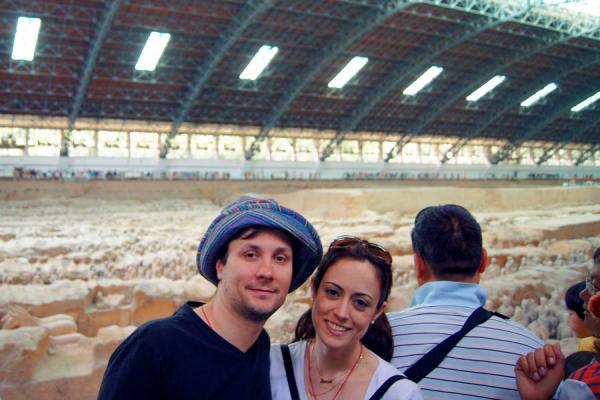Beihai Park
“Let's swing the oars, the boat pushes away the waves...”, this familiar Chinese song describes exactly the Beihai Park. Beihai Park. Containing the city's largest lake and a landmark white pagoda, it is the capital's oldest Imperial garden, with an 800-year history. Beihai Park, or Beihai Gongyuan, is the best single park to visit in Beijing, and a wonderful place to stroll, especially since it is within walking distance of the Forbidden City.
Beijing Beihai Park Facts

Brief Introduction
Beihai Park is located in the center of Beijing City, northwest of the Forbidden City, east of Jingshan, south of Zhongnanhai, north of Shichahai. Its entire area is about 690000 square meters, including 390000 square meters of water. Beihai Park used to be an imperial garden for emperors and royal families to leisure, recreation, government affairs dealing and sacrifice during the Liao, Jin, Yuan, Ming and Qing Dynasties. It is one of the oldest, the best-preserved, the most comprehensive and the most representative existing imperial gardens in China.
In 1992, it was honored by the Beijing Municipal People's Government as “one of Beijing's best tourist attractions - the earliest royal garden in the world”. For culture lovers and families who travel to Beijing, Beihai Park is one of top things to do.
The History of Beihai Park
As early as the Liao Dynasty, when Emperor Taizong established the capital in Yanjing (now Beijing) in the first year of Huitong (938), there was a lake in the northeastern suburbs of the city called "Jinhai", which was the predecessor of Beihai. After the Jin Dynasty conquered the Liao Dynasty, in the 3rd to 19th years of the Dading era of the Jin Dynasty (1163-1179), Emperor Shizong of the Jin Dynasty built the Daining Palace in imitation of the "Genyue Garden" in Bianliang (now Kaifeng, Henan Province) of the Northern Song Dynasty. At that time, the soil for digging "Jinhai" was expanded to "Qionghua Island" and the small hills surrounding the sea, and "Jinhai" was renamed "Xihuatan". Since then, Beihai has basically taken shape into a royal garden.
During the Yuan Dynasty, from 1264 to 1271, Kublai expanded Qionghua Island three times and rebuilt Guanghan Hall. In the 18th year of Yongle in the Ming Dynasty (1420 AD), the Ming Dynasty officially moved its capital to Beijing. Wanshou Mountain and Taiye Pool became the "Imperial Garden" to the west of the Forbidden City. After the Qing Dynasty established its capital in Beijing, Emperor Shizu of the Qing Dynasty, who was a devout Buddhist, in 1651, at the request of the Tibetan lama Naomu Khan, built a Tibetan-style White Pagoda on the site of the "Guanghan Hall" and constructed the "White Pagoda Temple" (now Yong 'an Temple) in front of the pagoda.
In 1925, it was officially opened to the public and named “Beihai Park”.
Significance
Beihai is the longest running and best preserved royal garden in China and the world. The royal families of various dynasties have been visiting and living here. In addition, it has always been one of the core places for the royal government to inquire about politics, offer sacrifices, celebrate ceremonies, pay homage to Buddha, seek immortality, and receive foreign clans and ambassadors during the feudal dynasty.
>> Recommended tour: 14-day China Wine Tasting Tour
What to Do & See
Designed with the concept of “One Pool Three Celestial Mountains” (Taiye Pool, Penglai Mountain, Abbot Mountain and Ying Chow Mountain, where live immortal celestial beings), Peking Beihai Park is full of rich fantasy mythic quality. The scenery here is particularly beautiful. There’re many famous and classic landscapes you should not miss when touring in the park.
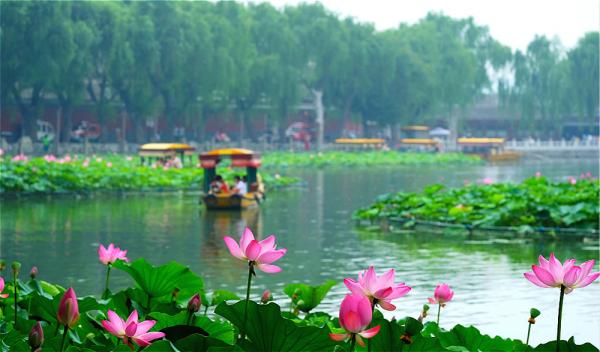
Round City (Tuan Cheng)
Located just outside the south entrance of the park, the Round City contains a distinctive countryard with pavilions, halls, corridors, bridges and ancient trees, a white jade Buddha statue enshrined in the hall, and a massive jade bowl that was once the prized possession of Kublai Khan.
White Dagoba
As the landmark of Beihai Park, White Dagoba has a Tibetan lamaist style. Different from most dagobas, the White Dagoba is hollow inside, with niches shrining silver boxes for Buddha Sarira. And there’re Lama Scriptures, Buddhist holy relics, as well as other tributes such as textiles, grains, medicinal materials, teas, fruits, etc. hided under the ground. In front of the dagoba stands the Hall of Good Cause (善因殿). The inside walls of the hall are made of 455 pieces of glazed tiles carved with Buddhist statues.
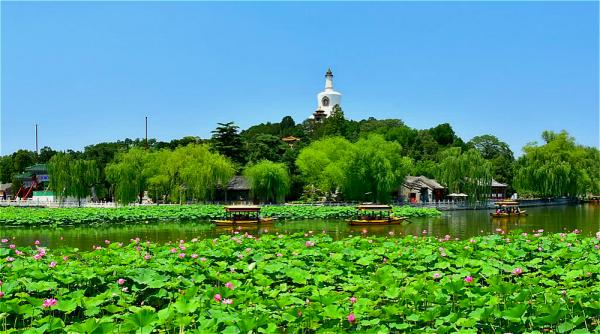
The Five Dragon Pavilions
Built in Ming Dynasty, the Five Dragon pavilions are 5 connected pavilions with spires and pointed upswept eaves, which look like a huge dragon when they appear together from a distance. They used to be a place for emperors, royal families and civil and military officials to fish, enjoy the glorious moon and dazzling fireworks.
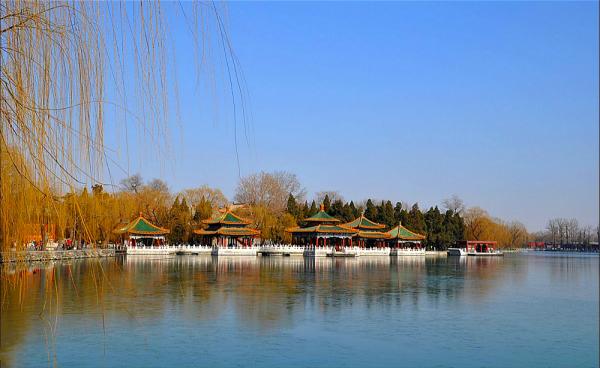
The Nine Dragon Screen
Built in 1756, the Nine Dragon Screen is 5.96 meters high, 25.52 meters long and 1.6 meters thick. It is one of the most delicate of China’s 3 surviving nine-dragon walls (the other 2 are respectively in the Forbidden City and Datong).The Nine Dragon Screen is made of glazed bricks of seven-colors. It has 9 huge vivid coiling dragons that play with pearls in the clouds on each side of the screen and big or small dragons in different postures on the two ends and eaves, which can count up to 635 dragons on the screen. Even nowadays, the Nine Dragon Screen is still well-preserved and bright in color, showing the superb and mature carving and painting techniques in ancient China.
Jingxin Study (Quiet Heart Room)
On the north bank, Jingxin Study is a garden within garden, which reflects the essence garden art of northern China. It covers an area of 4700 square meters, used to be the private study of crown prince during Qing Dynasty. There’re many gorgeous pavilions, halls, towers, corridors, bridges, pools, rockery fold stones, numerous odd-shaped rocks... all of them are artistically arranged and landscaped.
Beihai Park Boating
Beihai Park's 10 piers provide 460 boats in 10 categories, including 4-person seats, 6-person seats, 8-person seats, small ferry boats, large ferry boats and dragon boats.There are also 40 new antique boats to meet the needs of different visitors. Take a boat tour of Beihai Park is highly recommended for families with kids. >> Discover more Things to Do in Beijing with Kids
Beihai park by Night
The essence of the night tour of Beihai Park is mainly on the north shore. Entering through the North Gate and heading west, you'll see a series of illuminated landscapes: the glazed pagodas of the West Heavenly Brahma Realm, the Imitation Catering Tea House, the Gate of Truth in the Nine Dragon Wall, the Five Dragon Pavilion, the Temple of Elaboration of Blessings, the Little West Heaven, and the Juniper Monument in the Ten Thousand Buddhas Building. Along the way, you can also see the Qiong Island in the Taiyu Pond and the illuminated White Pagoda.
At the Jing Xin Zhai scenic spot in Beihai Park, night tour activities are also held every Friday and Saturday at 19:00 from July to August. Traditional Chinese folk music is performed by guzheng and dongxiao players. There will also be dancers dressed up in gorgeous ancient costumes performing traditional Chinese dances.
Please note: The White Pagoda, Five Dragons Pavilion, and Little West Heaven are illuminated on Fridays, Saturdays, and during festivals; the Dragon Wall is illuminated only on some holidays (e.g., National Day); and the rest of the area is illuminated nightly.
Other Activities
In addition to enjoy the classical landscape mentioned above, there’re also some interesting activities that you can participate in, such as boating, kicking shuttlecock, playing diabolo, chatting with the local elderly about the Imperial unofficial history of Beijing City, appreciating lotuses in Lotus Flower Festival (from the middle of July to the late August), taking part in Chrysanthemum Exhibition (every November of a year), joining the Blessing Culture Festival (from the 26th day of the twelfth lunar month to the seventh day of the first month every year), watching a Qing Dynasty army "ice play" (a show performed by college student volunteers, which reappears royal family's routine ice activities in winter during the Qing Dynasty), etc.
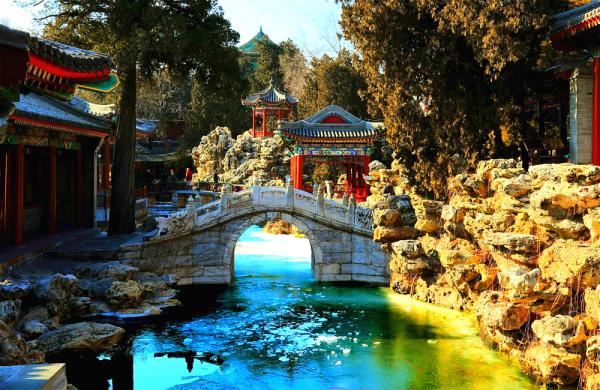
Peking Beihai Park Opening Hours
Peak Season (April 1st-October 31st): 6:30-21:00
Off Season (November 1st-March 31st): 6:30-20:00
Ticket Price
Peak Season (April 1st-October 31st):
Entrance Fee to Beihai Park: CNY 10
Combined ticket (including the inside pay sights – Qiongdao Island & Round City): CNY 20
Off Season (November 1st-March 31st):
Entrance Fee to Beihai Park: CNY 5
Combined ticket (including the inside pay sights – Qiongdao Island & Round City): CNY 15
Tips:
Ticket of Qiongdao Island: CNY 10
Ticket of Round City (Tuan Cheng): CNY 1
Best time to Visit Beihai Park
The best time of day to visit Beijing Beihai Park is from 6:30 to 9:00 in the morning and around 18:00 in the evening. These two times are less crowded and suitable for walking and taking photos. In the evening, you can visit Longze Pavilion on the west bank to watch the sunset.
>> Related reading: Best Time to Visit Beijing
How to Get to Beihai Park
By Subway
Take Subway Line 6 and get off at Beihai Bei Station.
By Bus
North Gate of Beihai Park: Take Bus 13, 42, 90, 107, 111, 118, 609, 612, 623 or 701 and get off at North Gate of Beihai Park.
East Gate of Beihai Park: Take Bus 5 or 609 and get off at Xibanqiao Station.
South Gate and Southwest Gate of Beihai Park: Take Bus 5, 101, 103, 109, 124, 619, Special Line 1 or Special Line 2 and get off at Beihai Station.
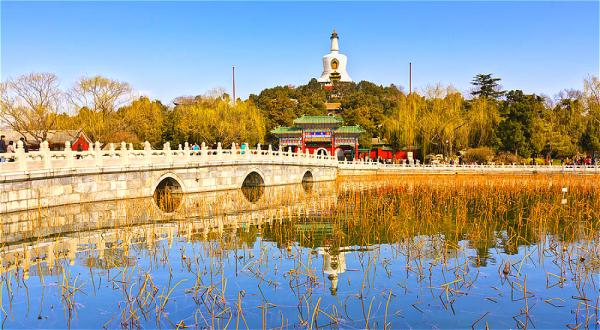
Travel Tips
1. No smoking, no pets allowed access and no fishing in the park.
2. The service time of Chinese and English-speaking guides beginning from 9:00 to 16:00, and the reservation of guides should be made 1 day ahead.
3. I suggest you combine the Forbidden City Tour or Jinshan Park Tour with Beihai Park Tour.
4. Wheelchair rentals are available for the elderly and tourists who can't walk much.

